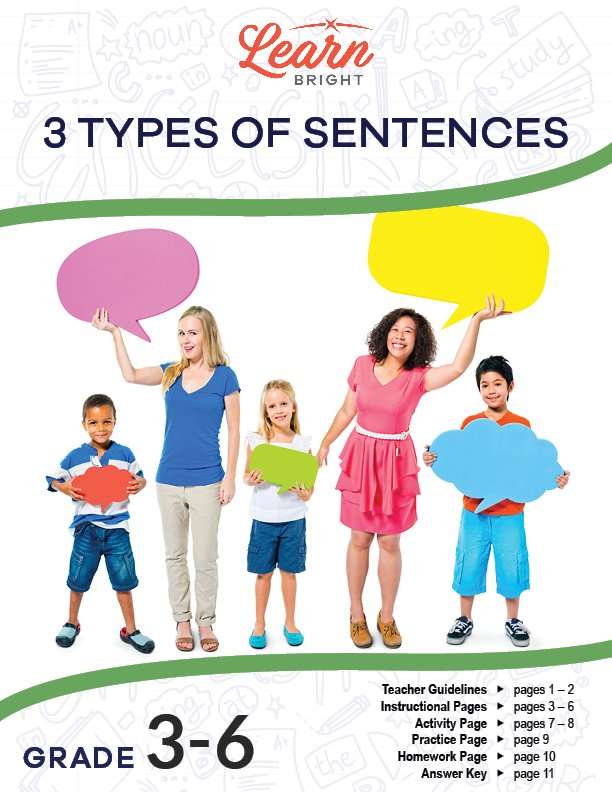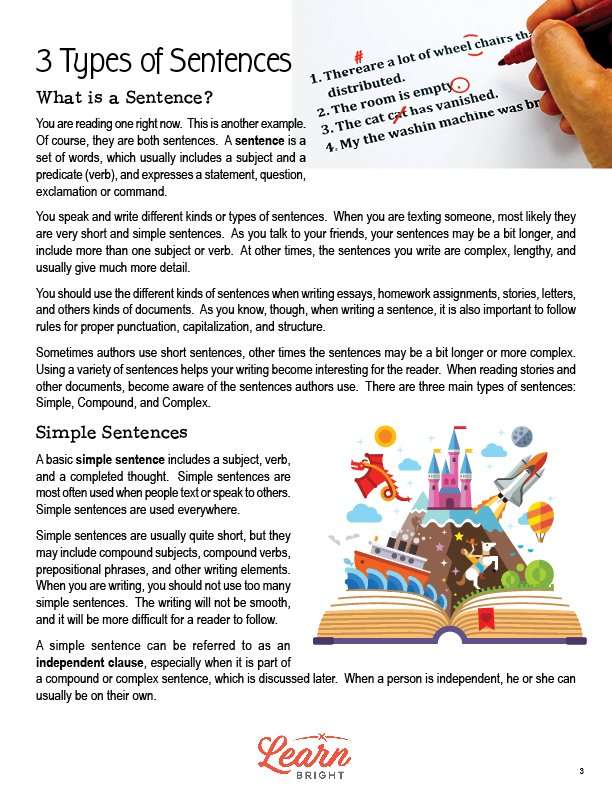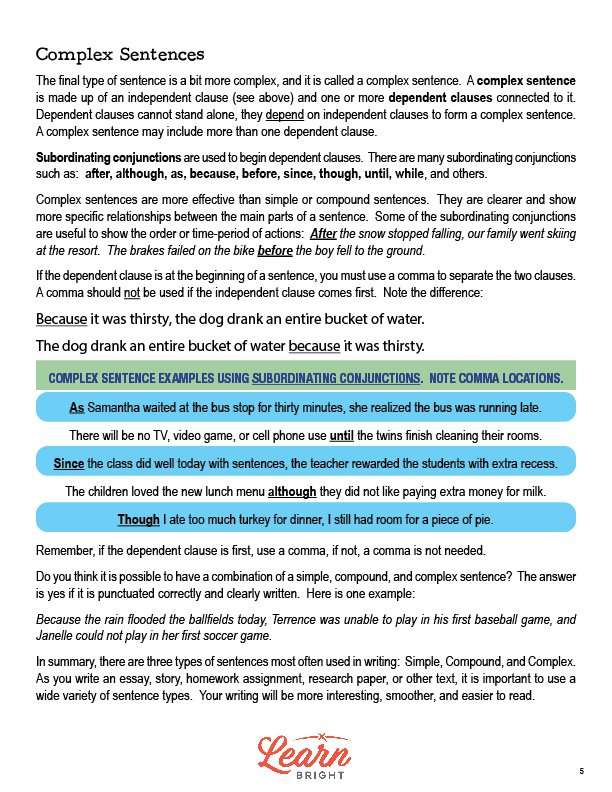Description
What our 3 Types of Sentences lesson plan includes
Lesson Objectives and Overview: 3 Types of Sentences helps students write better sentences, using compound and complex sentences when necessary, and teaches students to vary sentence structure when writing essays, stories, or other text. Students will practice identifying different types of sentences with an interactive game, played with a partner, in which they construct sentences to win points. They will also practice identifying sentence types on their own, practice their creative writing by constructing short stories using only one type of sentence at a time, practice inserting commas when needed, and identify conjunctions in a pre-written story. At the end of the lesson, students will be able to define, use, and contrast simple, compound, and complex sentences. This lesson is for students in 3rd grade, 4th grade, 5th grade, and 6th grade.
Classroom Procedure
Every lesson plan provides you with a classroom procedure page that outlines a step-by-step guide to follow. You do not have to follow the guide exactly. The guide helps you organize the lesson and details when to hand out worksheets. It also lists information in the orange box that you might find useful. You will find the lesson objectives, state standards, and number of class sessions the lesson should take to complete in this area. In addition, it describes the supplies you will need as well as what and how you need to prepare beforehand. For this lesson, the supplies you will need are the handouts and scissors. To prepare for this lesson ahead of time, you can find three sentences for the lesson opening, pair students for the activity, gather the supplies, and copy the handouts.
Options for Lesson
Included with this lesson is an “Options for Lesson” section that lists a number of suggestions for activities to add to the lesson or substitutions for the ones already in the lesson. The first suggestion is to expand the activity worksheet by planning a “Sentence Game” tournament. You can also add more words to the activity or have students write out each sentence that they create as a part of the “Sentence Game”. If you’d like the lesson to include a quiz, you could use the practice worksheet as one. You could also have students use some of their current reading material and identify the type of sentences used for additional practice. To expand the homework assignment or add another opportunity for practice, you could have students write short stories using only one type of sentence. A third of the class would write their stories only in simple sentences, a third in compound, and a third in complex. You could then have them exchange stories with each other and have them rewrite each other’s stories using a different kind of sentence. They could even vote on the best story at the end!
Teacher Notes
The teacher notes page includes a paragraph with additional guidelines and things to think about as you begin to plan your lesson. It notes that while students will have read and used complex and compound sentences already, they likely do not know how to define or identify them. Learning how to do that will help students become better writers. This page also includes lines that you can use to add your own notes as you’re preparing for this lesson.
3 TYPES OF SENTENCES LESSON PLAN CONTENT PAGES
What is a Sentence?
The 3 Types of Sentences lesson plan includes four content pages. The lesson begins with a definition of a sentence. A sentence is a set of words, which usually includes a subject and a predicate (verb), and expresses a statement, question, exclamation, or command. Everyone speaks, writes, and reads different kinds of sentences. You likely use different kinds of sentences for different things. For example, if you are texting someone, you’re likely using short and simple sentences, while the sentences you use to speak to your friends in person are longer and more complex. Different kinds of writing and speaking require different kinds of sentences, but you still have to make sure you’re using proper punctuation and grammar rules. Writers who use different types of sentences produce more interesting pieces of writing. The three main types of sentences are simple, compound, and complex.
Simple Sentences
Students will then learn about simple sentences, which includes a subject, verb, and a completed thought. We use them most often when texting or talking to other people, but we use them everywhere! Simple sentences tend to be short, but can also include compound subjects and verbs, prepositional phrases, and more. Using too many simple sentences in your writing can be confusing for the reader, as it will not flow smoothly. We also call simple sentences independent clauses, especially when they’re used as one part of a compound or complex sentence. Sentences that are independent clauses can stand on their own. The lesson then includes some helpful examples of basic simple sentences with compound subjects, verbs, or other elements. For example, the simple sentence “Noah ran home” can become “Noah and Elizabeth walked and ran home from school yesterday,” when some additional elements, like a compound subject, are added.
Compound Sentences
The next section of this lesson discusses compound sentences, which are made up of two independent clauses. We connect compound sentences using coordinating conjunctions. The list of coordinating conjunctions includes the following seven words: for, and, nor, but, or, yet, and so. Students can use the helpful mnemonic “FANBOYS” to remember them. Like simple sentences, using too many compound sentences on their own does not make for good writing. While compound sentences are useful, using too many can get confusing for a reader. The lesson then includes some examples of compound sentences that use coordinating conjunctions. One example is “Noah ran home from school today, but he will ride his bike to school tomorrow,” which uses the coordinating conjunction “but.” In all of the examples, if you remove the coordinating conjunction, you would create two separate sentences.
Complex Sentences
Finally, students will learn about complex sentences. These are made up of an independent clause and one or more dependent clauses. Dependent clauses, unlike independent ones, cannot stand alone. They depend on the independent clauses to create a complex sentence. Complex sentences can include multiple dependent clauses. Dependent clauses begin with subordinating conjunctions. Some common subordinating conjunctions include: after, although, as, because, before, since, though, until, and while. Complex sentences contain more information than simple or compound sentences, and can illustrate relationships between different parts of a sentence more clearly. Some subordinating conjunctions are useful for putting events in order, such as “after” and “before.”
If you use a dependent clause at the beginning of a sentence, you have to use a comma to separate clauses. However, you shouldn’t use a comma if the independent clause comes first. The lesson includes examples to illustrate both of these scenarios. It also includes examples of complex sentences that use subordinating conjunctions, with the correct comma placement. The lesson concludes with an example of a sentence that combines the three types of sentences. When combining the different types, it’s very important to make sure to use the right punctuation and to make sure to write as clearly as possible. Finally, the lesson reminds students that there are three main types of sentences (simple, compound, and complex) and that it’s important to use all of them when writing. Using various types of sentences makes your writing more interesting and easier to read!
Key Terms
Here is a list of the vocabulary words students will learn in this lesson plan:
- Sentence: a set of words, which usually includes a subject and a predicate (verb), and expresses a statement, question, exclamation, or command
- Simple sentence: includes a subject, verb, and a completed thought
- Independent clause: another term for a simple sentence, especially when it is part of a compound or complex sentence
- Compound sentence: a sentence made up of two independent clauses
- Coordinating conjunction: words used to connect the two parts of a compound sentence
- Complex sentence: a sentence made up of an independent clause and one or more dependent clauses
- Dependent clause: clauses that cannot stand alone, but must be connected to an independent clause
- Subordinating conjunctions: words used to begin dependent clauses
3 TYPES OF SENTENCES LESSON PLAN WORKSHEETS
The 3 Types of Sentences lesson plan includes three worksheets: an activity worksheet, a practice worksheet, and a homework assignment. You can refer to the guide on the classroom procedure page to determine when to hand out each worksheet.
SENTENCE GAME ACTIVITY WORKSHEET
Students will work in pairs for this activity worksheet. They will be opponents for a fun Sentence Game. First, they will cut apart the words on the accompanying page, fold them, and mix them together. They will then take turns choosing one word at a time. If they choose an orange word, they must use the word in a simple sentence, worth one point. If they choose a blue word, they must use it in a compound sentence, worth two points. Finally, if they choose a green word, they must use it in a complex sentence, worth three points. They must say the sentence out loud and correctly to earn the points. Whoever has the most points at the end of the game wins!
You can also have students work in larger teams for this activity if you’d prefer.
3 TYPES OF SENTENCES PRACTICE WORKSHEET
For the practice worksheet, students will complete two exercises. The first exercise has students determine if each sentence is simple, compound, or complex. They must also circle any conjunctions in the sentences. The second exercise has students read three paragraphs and add commas in the appropriate places. They must also circle the conjunctions. Both of these exercises test students’ understanding of the lesson material.
SHORT STORY HOMEWORK ASSIGNMENT
The homework assignment asks students to write three different versions of a short story that they come up with. The story can’t change from one version to the next. Students can only use the type of sentences that are designated for each version. Students must write the first version using only simple sentences. They must write the second version using only compound sentences, and the third version using only complex sentences.
Worksheet Answer Keys
This lesson plan includes an answer key for the practice worksheet. No answer keys are provided for the activity worksheet or the homework assignment, as students’ answers will vary. If you choose to administer the lesson pages to your students via PDF, you will need to save a new file that omits these pages. Otherwise, you can simply print out the applicable pages and keep these as reference for yourself when grading assignments.











